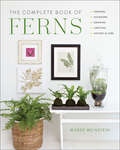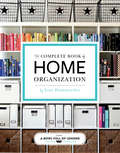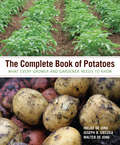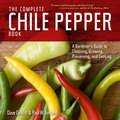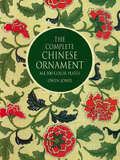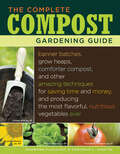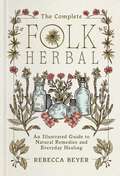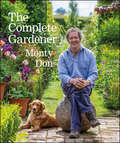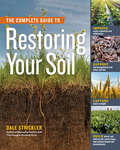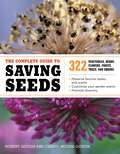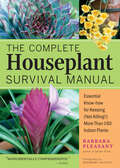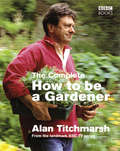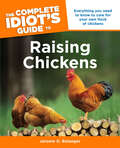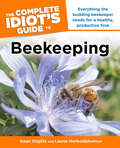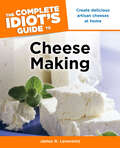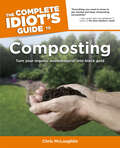- Table View
- List View
The Complete Book of Clean: Tips & Techniques for Your Home
by Toni Hammersley&“Hammersley&’s bible of clean covers every corner of the home from the bathroom to the office…hundreds of tips.&”—The Star From the bestselling author of The Complete Book of Home Organization, this foolproof, eco-friendly guide to cleaning your home provides solutions to help keep every area of your home neat, safe and spotless. Learn the best seasons to tackle home projectsFind storage solutions to simplify the processTeach even the messiest kids to clean up after themselvesKnow what needs a deep-clean—and how oftenSubstitute earth-friendly kitchen supplies for toxic chemicalsTackle every mess, stain and dust-magnet—and keep things from getting out of hand in the future Whether you&’re a neat freak or new to the world of homekeeping, let Toni Hammersley be your guide to establishing routines, learning techniques, and mastering the best home cleaning hacks out there. Soon you&’ll find that no matter the number of pets, kids, or home traffic, maintaining a clean home can be a breeze.
The Complete Book of Ferns: Indoors * Outdoors * Growing * Crafting * History And Lore
by Mobee Weinstein2021 American Horticultural Society Book Award Winner: “A lovely and multifaceted exploration . . . as useful as it is educational.” —Publishers WeeklyThe Complete Book of Ferns is filled with botanical information, indoor and outdoor growing and care information, details on propagation, display ideas, and even craft projects. This gorgeous book is authored by Mobee Weinstein, Foreman of Gardeners at the New York Botanical Garden and a veteran guest on Martha Stewart Living and other shows.From otherworldly Staghorns—mounted like antler trophies in homes throughout the world—to classic Boston Ferns and newer varieties like Crispy Wave, ferns are definitely back in fashion. And to no one’s surprise. After all, ferns are among the very oldest plants on the planet, with a long and storied history. There are tens of thousands of known varieties. In the Victorian Era, ferns were an absolute craze for over fifty years. They re-emerged as integral home décor in the ’50s and ’60s, and decorated the “fern bars” of the ’80s. And they’re back again.This comprehensive reference starts its examination of ferns 400 million years ago, when the first species of this group of spore-reproducing plants appeared on Earth, exploring their evolution and eventual incorporation into human culture, including the powers associated with them and their practical and ornamental uses. Then, after an exploration of fern botany—its parts, how it grows, its variability in size and form, habitats, propagation, etc.—you’ll learn how to green your indoor and outdoor environments with ferns. Every aspect of care is covered: potting/planting, watering, fertilizing, pest and disease control, and more.Finally, you can explore creative planting projects, like terrariums, vertical gardens (living walls), mixed tabletop gardens, and moss baskets, and create pressed fern art, fabric wall hangings with chlorophyll-stained designs, cyanotypes, and handmade fern-decorated paper. You’ll soon understand why this ancient plant class continues to be all the rage.
The Complete Book of Home Organization: 200+ Tips And Projects
by Toni HammersleyA &“super useful&” guide to making your home feel more spacious—and your life feel more manageable (Westchester Magazine). Have you ever wished you had the time and tools to organize your house in a clutter-free, design-conscious, Pinterest-worthy way? From storage solutions and cleaning tips to secret space-saving methods and expert strategies, The Complete Book of Home Organization is packed with the tips and shortcuts you need to effectively organize your home. From small spaces and apartment solutions to how to tackle a big, messy home with a 15-week total home organization challenge, this book covers it all. It spells out everything you need to de-clutter your house, store your belongings, and keep your home—and life—in tip-top shape. Organize the 30 main spaces of your home, including the living and dining spaces, bedrooms and bathrooms, guest areas, baby and kids&’ rooms, utility spaces and garages, entryways and offices, patios and decks, closets and pet areas. Keep track of your pantry, holiday and craft supplies, weekly menu planning, keepsakes, and schedules. From the basement to the attic, this book covers every nook and cranny. With step-by-step instructions, detailed illustrations, and handy checklists, it&’s time to say goodbye to a messy home and wasted storage space!
The Complete Book of Potatoes: What Every Grower and Gardener Needs to Know
by Hielke De Jong Walter De Jong Joseph B. SieczkaThe only comprehensive resource for home gardeners and commercial potato growers, The Complete Book of Potatoes has everything a gardener or commercial potato grower needs to successfully grow the best, disease-resistant potatoes for North American gardens. Includes practical as well as technical information about the potato plant, its origin, conventional and organic production techniques, pest management, and storage practices. The plant profiles include still life photographs of the exterior and interior of the tuber, and a succinct description of each variety’s physical and culinary qualities.
The Complete Chile Pepper Book: A Gardener's Guide to Choosing, Growing, Preserving, and Cooking
by Dave DeWitt Paul W. BoslandThe Complete Chile Pepper Book, by world-renowned chile experts Dave DeWitt and Paul W. Bosland, shares detailed profiles of the one hundred most popular chile varieties and include information on how to grow and cultivate them successfully, along with tips on planning, garden design, growing in containers, dealing with pests and disease, and breeding and hybridizing. Techniques for processing and preserving include canning, pickling, drying, and smoking. Eighty-five mouth-watering recipes show how to use the characteristic heat of chile peppers in beverages, sauces, appetizers, salads, soups, entrees, and desserts.
The Complete Chinese Ornament: All 100 Color Plates (Dover Fine Art, History of Art)
by Owen JonesThis sumptuous edition offers all 100 full-color plates from Owen Jones's definitive presentation of Chinese ornamentation and design, one of the most beautiful books on the decorative arts ever published. Now, over a centruy after its first publication, this remarkable work continues to provide an excellent, copyright-free source of authentic Chinese design and motifs. During the vast political tumult in China in the 19th century, many of the most exquisite examples of native art from the Ming, Ch'ing and earlier dynasties were spirited out of the country and sold into Western collections. One of the most spectacular of these assemblages was housed at London's South Kensington Museum (today The Victoria and Albert Museum). In the 1860s, the noted English designer and architect Owen Jones studed this collection in depth, particularly the wealth of superb examples of porcelain and cloisonné. He then meticulously rendered many of the most intriguing and beautiful designs in full color. These were published in his celebrated book, Examples of Chinese Ornament Selected from Objects in the South Kensington Museum and Other Collections (1867).This volume offers painstaking reproductions of all one hundred original color plates from that work, which delighted the art world of the time and exerted a profound influence on the subsequent history of Western design. Now that visual inspiration is once again available to artists, illustrators, designers, and craftspeople in this inexpensive high-quality edition. Moreover, any lover of fine art can enjoy the book as a splendid tribute to the glories of Chinese design--at a price far less than those commanded by extremely rare surviving copies of Jones's original work.
The Complete Compost Gardening Guide: Banner Batches, Grow Heaps, Comforter Compost, and Other Amazing Techniques for Saving Time and Money, and Producing the Most Flavorful, Nutritious Vegetables Ever
by Barbara Pleasant Deborah L. MartinDevelop mature compost right in your garden. Barbara Pleasant and Deborah Martin explain their six-way compost gardening system in this informative guide that will have you rethinking how you create and use your compost. With your plants and compost living together from the beginning, your garden will become a nourishing and organic environment that encourages growth and sustainability. You&’ll also find that the enriched soil requires less tending, weeding, and mulching, so you can do less back-breaking work for the same lush, beautiful results. This publication conforms to the EPUB Accessibility specification at WCAG 2.0 Level AA.
The Complete Folk Herbal: An Illustrated Guide to Natural Remedies and Everyday Healing
by Rebecca BeyerA definitive, beautifully illustrated guide to the folklore, history, and everyday utility of nearly 100 plants, trees, and shrubs.Reconnect with the wisdom of the land through this comprehensive guide from forager and ethnobotanist Rebecca Beyer. Richly illustrated and deeply researched, The Complete Folk Herbal celebrates nearly 100 plants, each one steeped in story, tradition, and healing power. Inside you&’ll find: - Detailed plant profiles covering origins, physical appearance, folklore, traditional uses, and modern applications. - Everyday remedies for headaches, burns, fatigue, insomnia, menstrual pain, and dozens of other common complaints. - Practical recipes for teas, tinctures, decoctions, salves, balms, and more. - Sustainable foraging practices that emphasize ethical harvesting and mindful stewardship of the earth&’s resources. Accessible yet encyclopedic, The Complete Folk Herbal is both a reference and an invitation to deepen your relationship with plants, honor the traditions of folk healing, and embark on a lifelong journey of herbal wisdom.
The Complete Gardener: A Practical, Imaginative Guide to Every Aspect of Gardening
by Monty DonWritten with passion and packed with practical information, Monty Don's The Complete Gardener is a must-read for anyone who wants to learn how to garden.Here, gardening legend Monty Don reveals the secrets of growing vegetables, fruits, flowers, and herbs while respecting the needs of the environment by gardening organically.Grounded in his own experience, Monty's straightforward gardening advice is paired with extraordinarily beautiful photographs taken over the course of a year in his own garden, taking you on a tour of his flower garden, herb garden, kitchen garden, and more.
The Complete Guide To Furniture Styles
by Louise A. BogerInstilling a cultivated taste for all authentically creative furniture! From ancient Greece and Rome, through medieval times, and up to the present day, domestic furniture has been an integral part of civilization, and its study reveals much about our history and culture. This classic guide to furniture styles discusses the development of domestic furniture in Europe, America, and China, detailing the great periods of French and English furniture from the Renaissance through the Empire and Regency periods. Furniture from every age is represented in over 600 photographs of pieces from major collections throughout the world. The book's highly readable style and extensive coverage make it a valuable resource for interior designers.
The Complete Guide to Contracting Your Home
by Kent Lester Dave McguertySave 30% on Home ConstructionWhether you want to take on all the responsibility of contracting your home or simply want to intelligently communicate with your homebuilder, The Complete Guide to Contracting Your Home can help you save 30% or more on the cost of home construction by teaching you the practical, day-to-day details of managing a construction project.You'll learn the up-front essentials to getting your project off to a solid start. You'll get financial and legal details in language you can understand. Learn the ins and outs of selecting a lot, dealing with suppliers, labor and subcontractors, safety, inspections and saving money so you can manage with authority, confidence and efficiency.You'll be walked through preconstruction, foundations, framing, roofing, plumbing, electrical, masonry, siding, insulation, drywall, trim, painting, cabinetry, countertops, flooring, tile and landscaping.Also included is the most comprehensive building resources section ever compiled. The appendix includes schedules, checklists, order forms, control logs and contracts you can't be without.
The Complete Guide to Restoring Your Soil: Improve Water Retention and Infiltration; Support Microorganisms and Other Soil Life; Capture More Sunlight; and Build Better Soil with No-Till, Cover Crops, and Carbon-Based Soil Amendments
by Dale StricklerHealthy soil is key to sustaining life on Earth. While more and more people are starting to see the need for soil restoration, there is very little understanding of just how it can be accomplished. There is a rapidly emerging demand for a &“how to&” manual for soil restoration. Dale Strickler is an expert on building healthy soil and restoring degraded soil, and in The Complete Guide to Restoring Your Soil, he presents the science of soil, along with proven methods of restoring depleted soil and agricultural practices from around the world that continue to build soil, rather than cause it to deteriorate. Strickler provides a solid foundation in the science of healthy soil, explaining how soil has become so degraded over time and the dire consequences for the human species, not just in terms of food scarcity but also the social, health, and environmental consequences of growing food in poor soil. He addresses the chemical, physical, and biological principles behind soil function, and presents actual farming practices that can be used to regenerate soil, techniques and strategies for remediating contaminated soil, and agriculture systems both past and present that functioned to build soil, such as the ancient chinampas systems of Mexico and the permaculture systems of today.
The Complete Guide to Saving Seeds: 322 Vegetables, Herbs, Fruits, Flowers, Trees, and Shrubs
by Robert E. Gough Cheryl Moore-GoughEnjoy your favorite varieties of garden plants year after year with this comprehensive guide to gathering, preparing, and planting seeds. Authors Robert Gough and Cheryl Moore-Gough provide simple instructions that clearly explain the whole process, from basic plant biology to proper seed storage and successful propagation. Gardeners of any experience level will find all the information they need to preserve genetic diversity, cut costs, and extend the life of their favorite plants to the next generation and beyond.
The Complete Houseplant Survival Manual: Essential Gardening Know-how for Keeping (Not Killing!) More Than 160 Indoor Plants
by Barbara PleasantIt&’s a whole new world of houseplants, so make yourself at home in it! If you love the idea of keeping houseplants, but struggle to care for them, you&’ll find solace and invaluable advice in this comprehensive guide from expert gardener Barbara Pleasant. Even experienced houseplant enthusiasts will benefit from Pleasant&’s expansive knowledge of indoor gardening, which includes personality profiles, growing needs, and troubleshooting tips for 160 blooming and foliage varieties. Create a greener world, one houseplant at a time.
The Complete How To Be A Gardener
by Alan TitchmarshWhether you're a complete beginner or a keen gardener, there are always times when it helps to have a reliable expert at your side. In The Complete How to be a Gardener, Alan Titchmarsh draws on his extensive knowledge and experience to give you a comprehensive guide to becoming a successful gardener. Alan starts with the fundamentals, covering the absolute essentials that every gardener needs to know, including information on how plants work and what they need to survive, as well as where to begin if you're a first-time gardener. Each chapter includes practical advice and step-by-step techniques and projects, as well as information on garden maintenance and a host of Alan's favourite plants to help you in your selection. With its perfect balance of down-to-earth information and inspirational garden ideas, this complete paperback edition of How to be a Gardener gets to the very heart of gardening and provides a comprehensive reference manual for any garden owner.
The Complete Idiot's Guide To Raising Chickens: Everything You Need to Know to Care for Your Own Flock of Chickens
by Jerome D. BelangerReaders will flock to this book Raising chickens is a growing trend hitting urban and suburban areas, as well as the country. The Complete Idiot's Guide® to Raising Chickens covers every aspect of raising chickens, whether one lives in the country, suburb, or city. People wanting their own supply of organic, additive-free, free-range eggs want to know how to keep their chickens healthy and egg producing. • How to choose what to start with-chicks, pullets, or hens • How best to feed and water • Coverage of the most popular breeds • Everything about eggs, including how to sell them
The Complete Idiot's Guide to Beekeeping: Everything the Budding Beekeeper Needs for a Healthy, Productive Hive
by Dean Stiglitz Laurie HerboldsheimerThe buzz on beekeeping. The Complete Idiot's Guide® to Beekeeping has all the information a beginning beekeeper needs to know to start a hive and keep it buzzing. Expert beekeepers Dean Stiglitz and Laurie Herboldsheimer, owners of Golden Rule Honey, take readers step by step through the entire process-from information on the inhabitants of a hive and how it works to collecting bees, keeping them healthy, raising a queen, harvesting honey and wax, and storing hives for the off-season.
The Complete Idiot's Guide to Cheese Making: Create Delicious Artisan Cheeses at Home
by James R. LeverentzBecome a cheese gourmet. The Complete Idiot's Guide® to Cheese Making is for both the hobbyist who will enjoy this traditional skill and organic food enthusiasts interested in wholesome, additive-free foods, offering readers the step-by-step process for making all variety of cheeses. • Covers the processes of creating Mascarpone, Ricotta, Neufchatel, Queso Fresco, Farmhouse Cheddar, Monterey Jack, Colby, Traditional Cheddar, Feta, Gouda, Havarti, and many more cheeses • The author created and sells a cheese-making kit voted best in the country by The Wall Street Journal • The eat-local movement, along with recent food-safety scares, has piqued an interest in producing one's own cheese
The Complete Idiot's Guide to Composting: Turn Your Organic Waste Material into Black Gold
by Chris McLaughlinWaste not, want notThe Complete Idiot's Guide® to Composting takes readers step by step through the process of selecting the right compost container, filling it with the right "ingredients," maintaining the mix at the right temperature and humidity, and using the end product. • A concise format, simplified approach, and thrift-conscious price Chris McLaughlin • Author is a Master Gardener and an expert on all forms of composting • Gardening has risen greatly in popularity in the last few years, with an added boost from First Lady Michelle Obama, and so has composting, which is cheap, effective, and environmentally friendly • Thousands of state, regional, and municipal programs have been developed to encourage composting and thus reduce landfill waste
The Complete Idiot's Guide to Decluttering: Win the Turf War with Your Stuff
by Regina LeedsDo you own your stuff—or does it own you? Whether someone lives in a mansion or a studio, drives an SUV or a Mini Cooper—stuff often builds up into an endless stream of clutter, taking over living spaces and complicating lives. Drawing on nearly two decades of experience organizing living and work spaces, renowned organizing expert Regina Leeds has the solution for conquering clutter in every room of one&’s house, along with in one&’s office, car, and garage. - Short, easy-to-use format. - Quick and easy steps for evaluating and organizing your possessions. - Unique room-by-room approach. - Tips on maintaining a clutter-free space—forever. - Includes a complete list of resources.
The Complete Idiot's Guide to Electrical Repair
by Terry MeanyThe Complete Idiot's Guide® to Electrical Repair is a basic instruction manual on home wiring and repair. The book covers AC/DC, volts, watts, fuses, and circuit breakers, national and local codes, and caution signs and safety concerns. Learn when it's best to do–it–yourself and when you need to bring in the pros. Also covered are extension cords and multiple strips, switches and receptacles, installing fixtures and adding new circuits, and working around existing wiring.
The Complete Idiot's Guide to Feng Shui, 3rd Edition
by Elizabeth Moran Joseph Yu&“An American masterpiece that tops the lot.&” —Feng Shui For Modern LivingConsidered the feng shui bible by classical practitioners and teachers, The Complete Idiot&’s Guide® to Feng Shui has been updated to include more case studies and feng shui readings to make the practical application of feng shui even more accessible; new chapters feature before and after photos of feng shui makeovers and explain Ming Gua—the Guardian Star that influences a person&’s character—and much more. • One of the few Western books that focuses on &“classical&” feng shui, which is growing in popularity now that the topic has become more mainstream • Joseph Yu is one of only five world-renowned classical feng shui masters
The Complete Idiot's Guide to Getting Organized Fast-Track: The Core Advice You Need to Get and Keep Your Life in Order
by Cynthia EwerTurn organzing your space into your next great project with this comprehensive guide!In our materialistic, time-crunched society, lifestyles are compromised by disorganization and clutter. In a 2008 National Association of Professional Organizers survey, 65 percent of respondents noted that their household was at least moderately disorganized, 71 percent said their quality of life would improve if they were better organized, and 96 percent of respondents indicated that they could save time every day by becoming more organized. A survey by IKEA reported that only 11 percent of Americans know where their Social Security cards are. Unfortunately, the problem has gotten so out of hand for so many, they have no idea where to begin.The Complete Idiot's Guide® to Getting Organized Fast-Track, finds readers where they are and helps them take the first steps toward a more organized and efficient life. In this book readers get: • The principles behind effective organizing that can be applied to any situation in the home or office. • A plan for clearing paper clutter and putting important documents where they can be found. • Commonsense thoughts on prioritizing and letting go of objects that are no longer useful. • A system for categorizing possessions that does not require people to buy more stuff to organize the stuff they already have. • Tips for tackling disorganization hot spots, including home offices or dens, kitchens, closets, master bedrooms, garages, attics, and basement areas. • Advice for staying ahead of messy family members or coworkers who can undo a person's hard work in an instant.
The Complete Idiot's Guide to Green Cleaning, 2nd Edition: Nontoxic and Chemical-Free Methods for a Clean and Healthy Home
by Linda Formichelli Mary FindleyBecome a green cleaning machine. Fully updated and revised to focus on cleaning the "green" way-naturally, with no chemicals-this guide takes readers room-by- room, teaching them how to clean thoroughly, efficiently, and in an environmentally sound way. New and expanded coverage includes info on making small changes that have a huge impact on cleaning difficult areas, green-ifying personal care products, and more. *Provides specific cleaning hints and teaches how to clean quickly and efficiently *Uses only common ingredients, but also provides suggestions for alternatives that readers might like better
The Complete Idiot's Guide to Household Solutions
by Melodie MooreYou're no idiot, of course. You know that you should be able to fix that leaky faucet, clean those messy pots, and save on your heating bill. But when it comes to dealing with those never-ending chores and dilemmas, you feel like a slave to your home. Unlock those shackles now! The Complete Idiot's Guide® to Household Solutions helps make you lord or lady of the manor again, with thousands of hints and tips for getting things done quicker, cheaper, easier, and smarter. In this Complete Idiot's Guide® you get: Valuable tips that help you save money on decorating, entertaining, and travel. Idiot-proof solutions for keeping your kitchen, garage, and home office in tip-top shape. Easy-to-follow instructions for home repairs and lawn and garden maintenance. More than 75 formulas for household cleaning, pet products, tried-and-true home remedies, and more! MELODIE MOORE, former CPA, is the founder and editor of Tightwad Living, a mini-magazine that focuses on time and money-saving household solutions. Moore's articles have been published in numerous magazines, and her books, The Frugal Almanac, Smart Cents, and Vim and Vinegar, have helped thousands of people with their everyday chores and dilemmas. Inside You Will Find Ways: Save on car and travel expenses. Eat better for less. Solve everyday health and beauty problems. Eliminate pet odors. Get rid of bugs. Polish furniture. Remove stubborn decals. Simplify home repairs-indoors and out. Enjoy more family fun times. Never pay full price for anything again!

